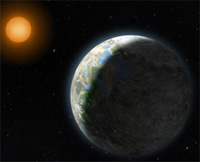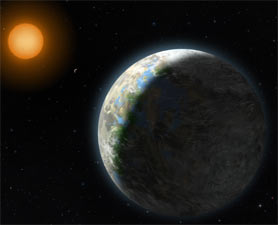 Located in a solar system that parallels our own, the new world could be habitable -- or even inhabited.
Located in a solar system that parallels our own, the new world could be habitable -- or even inhabited.
A new member in a family of planets circling a red dwarf star 20 light-years away has just been found. It's called Gliese 581g, and the 'g' may very well stand for Goldilocks.
Gliese 581g is the first world discovered beyond Earth that's the right size and location for life.
"Personally, given the ubiquity and propensity of life to flourish wherever it can, I would say that the chances for life on this planet are 100 percent. I have almost no doubt about it," Steven Vogt, professor of astronomy and astrophysics at
A new member in a family of planets circling a red dwarf star 20 light-years away has just been found. It's called Gliese 581g, and the 'g' may very well stand for Goldilocks.
Gliese 581g is the first world discovered beyond Earth that's the right size and location for life.
"Personally, given the ubiquity and propensity of life to flourish wherever it can, I would say that the chances for life on this planet are 100 percent. I have almost no doubt about it," Steven Vogt, professor of astronomy and astrophysics at
The discovery caps an 11-year effort to tease out information from instruments on ground-based telescopes that measure minute variations in starlight caused by the gravitational tugs of orbiting planets.
Planet G -- the sixth member in Gliese 581's family -- orbits right in the middle of that system's habitable region, where temperatures would be suitable for liquid water to pool on the planet's surface.
 "This is really the first 'Goldilocks' planet, the first planet that is roughly the right size and just at the right distance to have liquid water on the surface," astronomer Paul Butler, with the Carnegie Institution in Washington, D.C., told reporters during a conference call Wednesday.
"This is really the first 'Goldilocks' planet, the first planet that is roughly the right size and just at the right distance to have liquid water on the surface," astronomer Paul Butler, with the Carnegie Institution in Washington, D.C., told reporters during a conference call Wednesday.
"Everything we know about life is that it absolutely requires liquid water," he added. "The planet has to be the right distance from the star so it's not too hot, not too cold... and then it has to have surface gravity so that it can hold on to a substantial atmosphere and allow the water to pool."
With a mass three times larger than Earth's, the newly discovered world has the muscle to hold atmosphere. Plus, it has the gift of time. Not only is its parent star especially long-lived, the planet is tidally locked to its sun -- similar to how the moon keeps the same side pointed at Earth -- so that half the world is in perpetual light and the other half in permanent darkness. As a result, temperatures are extremely stable and diverse.
"This planet doesn't have days and nights. Wherever you are on this planet, the sun is in the same position all the time. You have very stable zones where the ecosystem stays the same temperature... basically forever," Vogt said. "If life can evolve, it's going to have billions and billions of years to adapt to the surface."
"Given the ubiquity of water, it seems probable that this thing actually has liquid water. On the surface of the Earth, everywhere you have liquid water you have life," Vogt added.
The question wouldn't be to defend that there is life at Gliese 581g, says
Current technologies won't allow scientists to study the planet's atmosphere for chemical signs of life, but astronomers expect many more similar life-friendly planets to be discovered soon. If one or more of those cross the face of their parent star, relative to our line of sight, then it's possible to gather atmospheric data.
"This system is not in an orientation such that this planet would ever transit, so unfortunately this is not a case where nature has thrown us a bone," Vogt noted. "That being said, it is so close and we have found this thing so soon that it suggests we will start finding a lot of these things in the future and eventually we will find systems that do transit. This is a harbinger of things to come."
The research appears in this week's issue of Astrophysical Journal.

 Previous page
Previous page Back to top
Back to top







